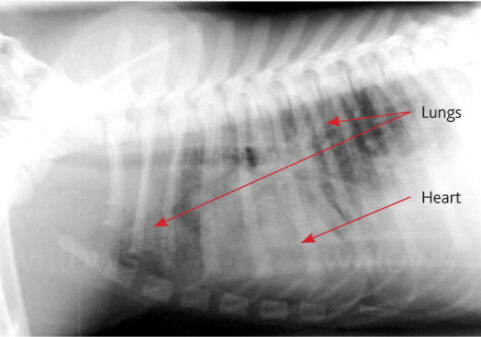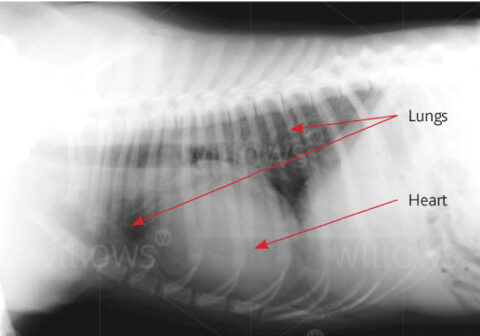Is your dog at risk?
In recent years a new parasite has become more prevalent in the local area of Solihull. Angiostrongylus vasorum, or lungworm used to be considered a problem confined to the South West and Wales, however it has been increasingly diagnosed in dogs in the local area.

How are dogs infected?
This parasite infects dogs when they eat infected slugs, snails or frogs. Some dogs will eat these slimy creatures on purpose; however, most are incidentally infected while eating grass. Most, but by no means all the dogs seen with this condition are young due to their inquisitive nature.
When a dog is infected, the adult worms live and reproduce in the heart and blood vessels of the lung. They lay eggs which hatch to larvae, which are then coughed up and swallowed. They pass through the dog’s digestive tract and out in its faeces. Slugs and snails are infected by ingesting (eating) the larvae which have contaminated the environment. These creatures are then consumed by a dog (or fox, which can act as a reservoir for the parasite) and the cycle begins again.

What are the clinical signs of lungworm?
Some dogs develop signs of coughing, reduced exercise tolerance or breathlessness. These signs are associated with the presence of the worms in the heart and large blood vessels and the damage done to the lungs as the larvae work their way out. Some dogs, however, do not show these signs but develop even more worrying problems.
The presence of lungworm can lead to poor blood clotting, which means that these unfortunate dogs sometimes present with bleeding problems. Neurological (nervous) signs such as seizures (fits) and back pain can also be seen. If left untreated these problems can be life threatening.

Chest X-ray of a four-month-old Springer Spaniel with Angiostrongylus vasorum before treatment. The lungs show patchy whitish densities due to the lungoworm infestation (lungs should normally look dark due to the presence of air). As a result of the densities in the lungs, the heart shadow is not properly visible (compare with the X-ray taken after treatment).

The lungs are darker due to better filling with air, and the heart shadow is more clearly visible
How is lungworm diagnosed?
Definitive diagnosis is made by identification of the larvae which are immature worms, usually by looking at a sample of faeces from the affected dog but also sometimes by looking at washes taken from the lungs by the vet (a technique known as broncho-alveolar lavage).
X-rays, endoscopy, and blood tests may also be required in investigation of this condition. Occasionally your Vet may ‘test treat’ for lungworm when we suspect it could be causing a problem, however it is not possible to identify the larvae.
Treatment
Treatments are now available in the form of specific anti-parasitic treatments, unfortunately some dogs may still die despite diagnosis and appropriate therapy.
Prevention
With such worrying clinical signs associated with lungworm, prevention is obviously better than cure. There are now multiple treatments which, when used monthly, prevents lungworm in dogs, however, it is important to note that not all anti-parasite preparations kill lungworm, so please check with your Vet which product best suits your needs.
Apart from regular medication, other tips for reducing risk of your dog becoming infected include cleaning toys which have been left out, not leaving food or water bowls outside, or if this is necessary then cleaning them daily.
Please note that you are unlikely to significantly reduce the slug and snail population in your garden by using excessive quantities of slug bait. Slug pellets, which contain metaldehyde, are extremely toxic to dogs and should be used with extreme care – if at all – when pets or children are around.
Dog Health Information
Find out more
To assist owners in understanding more about a health conditions that are specific to dogs we have put together a range of information sheets to talk you through some of the more common health concerns seen and treated by our General Practice Vets.

